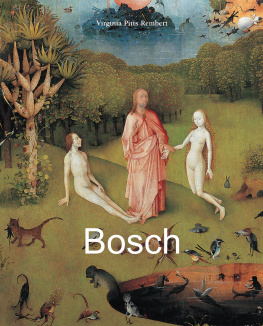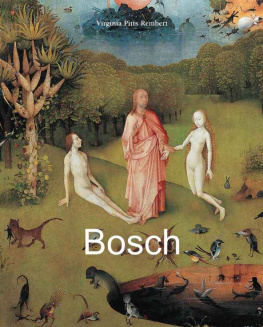Virginia Pitts Rembert
BOSCH
Hieronymus B osch and the Lisbon Temptation:
a view from the 3rd millennium

Author: Virginia Pitts Rembert
Parkstone Press Ltd, New York, USA
Confidential Concepts, worldwide, USA
Kingdom of Spain, GALA-Salvador Dali Foundation / Artists Rights Society, New York, USA / VEGAP, Madrid
ISBN : 978-1-78310-728-5
All rights reserved
No part of this publication may be reproduced or adapted without the permission of the copyright holder, throughout the world.
Unless otherwise specified, copyrights on the works reproduced lies with the respective photographers. Despite intensive research, it has not always been possible to establish copyright ownership. Where this is the case we would appreciate notification.
Contents

Pieter Jansz Saenredam (1597-1665), The Choir of the Church of Saint John, Bois-le-Duc, drawing, British Museum, London

Pieter Jansz Saenredam (1597-1665), View of Bois-le-Duc with the Church of Saint John , 1632, Royal Museums of Fine Arts of Belgium, Brussels
Preface
History has been called a seamless web, although human beings insiston giving it arbitrary divisions. While segments of hours, months and years have little meaning, save for convenience, we assign great powerto them, especially when they reach the dimensions of centuries and millennia. The French have a name fin-d e-sicle for the malaise that seizes its citizens at the end of a century. A millennial change carries even more power, especially since Christ promised to return at the end of the first 1000 years after His death in order to pass judgment on the faithful and the faithless.
At the approach of the year 1000 CE, people believed that the Judgment predicted by Christ to occur at the Millennium was imminent. When it did not come in 1000, or near that time, the chronicler and Cluniac monk, Raul Glaber, wrote: there occurred, throughout the world, especially in Italy and Gaul, a rebuilding of church basilicas. Notwithstanding the greater number were already well established and not in the least in need, nevertheless each Christian people strove against the others to erect nobler ones. It was as if the whole earth, having cast off the old by shaking it self, were clothing itself everywhere in the white robe of the church. ( Holt, 48)
On April 6, 1997, according to the NewYorkTimes o f a day earlie r, the countdown to the third millennium began in the United States of America.

The Cathedral of Saint John, s - Hertogenbosch
The fanfare that accompanied the announcement anticipated the celebration in New York City and around the world when the 000-day countdown would be complete, on January 1, 2000. Restaurants were already accepting reservations for the celebrations of that evening. On every hand there were fortuitous as well as dire predictions for the end of one century and the beginning of the next.
President Bill Clinton, who ran on the Democratic Platform in 1996 as a bridge to the 21st century, was still making predictions for the great social and economic future of America and the world for which he would help prepare the way. Even so, troublesome glitches marred the utopian view. Computers were expected not to recognize as 2000 but as 1900, resulting in shutdowns that could affect government functions from the payment of Medicare claims to control of the nations air traffic system. In fact, failure to address the problem universally was predicted by some to lead to catastrophic global consequences.
Religious and prophetic cults had already appeared with more regularity than in the usual fin-de-sicle periods. As early as 1980 saw the beginning of the many survivalist cults to come in the next two decades when an Arkansan, named Kurt Saxon, warned the audience of the National Broadcast Companys Tomorrow show, that everyone should be prepared to live off the land and keep an arsenal for self-protection against the marauding bands that would follow the coming nuclear holocaust (Arkansas Gazette, 7/29/80). The solemn projections of the end of the world reached their most modernized climax in 1997, when members of a computer-related cult followed their leader, Marshall Herff Applewhite, in a suicide contract to beam themselves up to a spaceship presumably trailing in the wake of the Hale-Bopp Comet that was plunging through the Heavens that year.

Sculpture at the Cathedral of Saint John, s - Hertogenbosch

Anonymous, Portrait of Hieronymus Bosch , c.1550, red and black chalk drawing in the Arras Codex , x cm , Municipal Library, Arras
An essayist in TheNewYorker commented on their fantastically flawed mission: Though science is stronger today than when Galileo knelt before the Inquisition, it remains a minority habit of mind, and its future is very much in doubt. Blind belief rules the millennial universe, dark and rangy as space itself (4/14/97, 32).
That many believed the fate of science and rational thought to be in jeopardy was reflected in an article in the NYT entitled Scientists Deplore Flight From Reason (6/6/95). Scientists, doctors, educators, and other intellectuals meeting on the subject at the New York Academy of Sciences proclaimed a call to arms against various threats to rational behavior. These included traditional hobgoblins such as astrology and religious fundamentalism; new to the times were the post-modernist critics of science who contended that truth in science depended on ones point of view, not on any absolute content. In such an environment, it was said irrational ideas had taken hold in popular commerce. Paranormal nostrums rampant among the public included belief in angels, out of body and near-death experiences, as well as abduction by aliens and multiple reincarnations. Seeming to reinforce the NYAS conference presumptions were references that abounded in the national media to increased interest in astrology, psychic phenomena, and magic as well as the related fields of Satanism and witchcraft.
An article on witchcraft (NYT, 10/31/98) centered around a group of Wiccans (the modern name of so-called witches, derived from a neo-pagan, pseudo religious group called Wicca) operating in Salem, Massachusetts. That city, site of the 17th-century witches trials, was said to have become a center of tolerance for alternative spirituality, including New Age beliefs and contemporary witchcraft groups such as the Temple of Nine Wells and the Witches League for Public Awareness: Claiming that theirs is a peaceful, nature-oriented religion, quite unlike early devil-worshipping societies, the Wiccans have organized educationally, even politically, to correct misapprehensions about wit ches and their modern motivations.

Next page


![Majkl Konnelli - The Night Fire [Harry Bosch - 22]](/uploads/posts/book/873181/thumbs/majkl-konnelli-the-night-fire-harry-bosch-22.jpg)
















